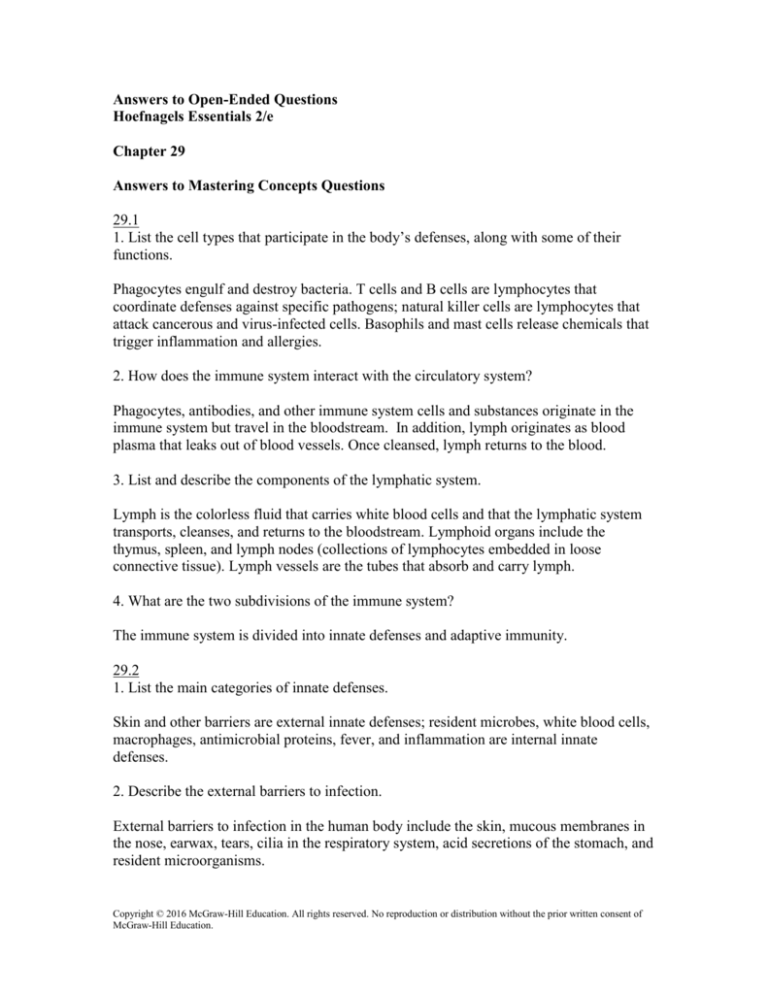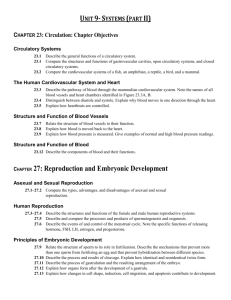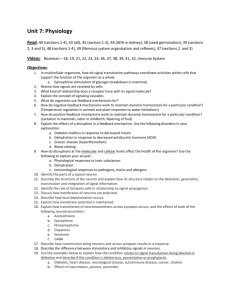
Answers to Open-Ended Questions
Hoefnagels Essentials 2/e
Chapter 29
Answers to Mastering Concepts Questions
29.1
1. List the cell types that participate in the body’s defenses, along with some of their
functions.
Phagocytes engulf and destroy bacteria. T cells and B cells are lymphocytes that
coordinate defenses against specific pathogens; natural killer cells are lymphocytes that
attack cancerous and virus-infected cells. Basophils and mast cells release chemicals that
trigger inflammation and allergies.
2. How does the immune system interact with the circulatory system?
Phagocytes, antibodies, and other immune system cells and substances originate in the
immune system but travel in the bloodstream. In addition, lymph originates as blood
plasma that leaks out of blood vessels. Once cleansed, lymph returns to the blood.
3. List and describe the components of the lymphatic system.
Lymph is the colorless fluid that carries white blood cells and that the lymphatic system
transports, cleanses, and returns to the bloodstream. Lymphoid organs include the
thymus, spleen, and lymph nodes (collections of lymphocytes embedded in loose
connective tissue). Lymph vessels are the tubes that absorb and carry lymph.
4. What are the two subdivisions of the immune system?
The immune system is divided into innate defenses and adaptive immunity.
29.2
1. List the main categories of innate defenses.
Skin and other barriers are external innate defenses; resident microbes, white blood cells,
macrophages, antimicrobial proteins, fever, and inflammation are internal innate
defenses.
2. Describe the external barriers to infection.
External barriers to infection in the human body include the skin, mucous membranes in
the nose, earwax, tears, cilia in the respiratory system, acid secretions of the stomach, and
resident microorganisms.
Copyright © 2016 McGraw-Hill Education. All rights reserved. No reproduction or distribution without the prior written consent of
McGraw-Hill Education.
3. Which white blood cells participate in innate defenses?
Examples of white blood cells that participate in innate defenses include phagocytes,
which engulf bacteria; basophils, which promote inflammation; and natural killer cells,
which attack cancerous or virus-infected cells.
4. How can inflammation be both helpful and harmful?
Inflammation can be helpful because it recruits immune components, helps clear debris,
and creates an environment hostile to microorganisms around the site of injury or
infection. Inflammation can also be harmful because it can cause the site to become
swollen and painful. Also, joints and other body parts can become chronically inflamed
even if they are uninfected, causing great discomfort.
5. How is fever protective?
Fever creates an environment that is hostile to bacteria and viruses. Not only does the
warmer temperature inhibit some bacteria and viruses, it also reduces the iron level in the
blood, depriving bacteria and fungi of iron and reducing their replication. Fever also
increases the activity level of phagocytes.
29.3
1. What is the relationship between antigens and antibodies?
Antigens are molecules that trigger the production of antibodies.
2. What is the role of macrophages in adaptive immunity?
In adaptive immunity, the macrophages engulf invading cells and then display foreign
antigens on their surfaces. Helper T cells recognize these antigens and bind to the
macrophage. This initiates other phases of the cell-mediated and humoral responses.
3. Compare and contrast the two subdivisions of adaptive immunity.
Adaptive immunity includes cell-mediated and humoral responses. Both are stimulated
by activated helper T cells, act against specific targets, and result in the production of
memory cells. Cell-mediated immunity requires the participation of cytotoxic T cells,
which engulf and destroy cancerous cells or cells that are infected with viruses. Humoral
immunity requires the participation of B cells, which secrete antibodies that bind to
antigens in body fluids.
4. Describe the structure and function of an antibody.
An antibody is a Y-shaped protein that corresponds to a specific antigen. Upon
encountering an invader with a corresponding antigen, the antibody binds to the antigen.
This may make the antigen more noticeable to macrophages, inactivate a microbe, or
Copyright © 2016 McGraw-Hill Education. All rights reserved. No reproduction or distribution without the prior written consent of
McGraw-Hill Education.
neutralize its toxins. Viruses coated with antibodies may not be able to attach to target
cells. Antibodies also trigger the production of complement proteins that destroy
microbes.
5. What happens after a B cell is activated?
An activated B cell can proliferate, producing memory cells, or it can produce plasma
cells that make antibodies to fight the current infection.
6. Explain the difference between the primary and secondary immune response.
The primary immune response is triggered the first time the body encounters a pathogen;
a secondary immune response is triggered on subsequent exposure. A primary immune
response may take days or weeks to respond to the infection. The secondary immune
response is much quicker and stronger than the primary response.
7. What happens if an immune reaction persists after a pathogen is eliminated?
If the immune reaction persists too long, the immune system’s chemicals may begin to
attack the body’s own cells.
29.4
1. What is a vaccine?
A vaccine is a mixture containing antigens that stimulate the immune response without
actually causing disease.
2. List the main types of vaccine formulations.
Vaccines can be composed of live but weakened pathogens, inactivated pathogens or
toxins, or subunits of pathogens.
3. Why haven’t scientists been able to develop vaccines against HIV and the common
cold?
These viruses mutate too frequently for a vaccine to be effective.
29.5
1. How might autoimmunity arise?
One event that might lead to autoimmunity includes the survival of lymphocytes that
correspond to the body’s molecules. These lymphocytes are ordinarily destroyed early in
development, but if they survive, they can cause autoimmunity.
2. Which immune system cells does HIV attack, and what is the consequence?
Copyright © 2016 McGraw-Hill Education. All rights reserved. No reproduction or distribution without the prior written consent of
McGraw-Hill Education.
HIV attacks helper T cells, causing the body’s immune response to fail. Once too many T
cells are lost, the person becomes susceptible to opportunistic illnesses and infections.
3. Which cells and biochemicals participate in an allergic reaction?
The cells that participate in an allergic reaction include B cells and mast cells.
Biochemicals include the allergen’s antigens, the antibodies secreted by plasma cells, and
the histamine released from mast cells.
Write It Out
1. Explain the observation that lymphoid tissues are scattered in the skin, lungs, stomach,
and intestines.
The skin, lungs, stomach, and intestines are all in contact with the outside world, so they
are places where pathogens are likely to enter the body.
2. Explain why a scraped knee increases the chance that pathogens will trigger an
adaptive immune response.
A scraped knee opens the skin, allowing pathogens to bypass an important innate
defense. Once in the body, the pathogens may multiply and initiate the adaptive immune
response.
3. In an effort to reduce allergic responses, a drug company wishes to develop a
medication that binds to and kills mast cells. What would be a side effect of this drug?
Mast cells release the histamine that accompanies an allergic reaction. However, mast
cells and histamine also have important functions in innate immunity against pathogens.
When pathogens enter the skin, mast cells release histamine, which triggers
inflammation. These reactions are helpful because they recruit other immune
components, help clear debris, and create an environment hostile to microorganisms
around the site of injury or infection. If a drug targets and kills mast cells, then the
inflammation response would not occur, and the immune system would be less likely to
quickly fight the infection.
4. Dead phagocytes are one component of pus. Why is pus a sure sign of infection?
Phagocytes fight infection by engulfing and destroying bacteria and damaged tissues. Pus
is a fluid containing these white blood cells and other debris.
5. Since fever has protective effects, should we avoid taking fever-reducing medications
when ill? Use the Internet to research the consequences of overmedicating a fever and the
risk of allowing fever to rise too high.
Copyright © 2016 McGraw-Hill Education. All rights reserved. No reproduction or distribution without the prior written consent of
McGraw-Hill Education.
Fever is the immune system’s natural response to invading pathogens. It creates a harsh
environment for many invaders, helping the immune system to eliminate them. Taking
medications to reduce a moderate to high fever (less than 105 degrees F) is generally not
recommended since it can prolong the illness. However, very high fevers can sometimes
cause seizures in children. A high fever can also cause dehydration, so a person with a
fever should drink plenty of water.
6. Briefly explain the function of each innate and adaptive defense shown in figure 29.16.
Resident microorganisms prevent colonization by pathogens; white blood cells play many
roles in innate and adaptive defenses; macrophages engulf pathogens and present
antigens to helper T cells; skin blocks pathogens from entering the body; antimicrobial
proteins have many roles, such as directly killing pathogens; inflammation helps clear
debris and recruits immune cells; fever creates a hostile environment for pathogens;
effector helper T cells initiate and coordinate the adaptive immune response; memory
helper T cells initiate the secondary immune response; plasma cells secrete antibodies;
antibodies inactivate pathogens and neutralize toxins; memory B cells help initiate the
secondary immune response; effector cytotoxic T cells destroy infected or cancerous
cells; memory T cells help initiate the secondary immune response.
7. What do a plasma cell and a memory cell descended from the same B cell have in
common, and how do they differ?
Both plasma and memory cells are produced after activation of B cells. Plasma cells
secrete huge number of antibodies. Memory cells linger after the infection subsides.
Upon subsequent contact with the same pathogen, memory cells rapidly transform into
plasma cells that produce antigen-specific antibodies.
8. Which do you think would be more dangerous, a deficiency of T cells or a deficiency
of B cells? Explain your reasoning.
Both would be dangerous, but helper T cells coordinate the immune response (including
triggering the activity of B cells), so a deficiency of T cells would be more dangerous.
9. As a treatment for bladder cancer, physicians may inject bovine tuberculosis bacteria
into the patient’s bladder. The bacteria bind to the bladder wall. Scientists do not fully
understand why this treatment causes the patient’s immune system to launch an attack
against the cancer cells. Using your knowledge of how the immune system is activated,
write a prediction for how an injection of bovine tuberculosis bacteria might help a
patient’s immune system fight cancer.
The tuberculosis bacteria somehow initiate an immune response against the cancerous
cells. Perhaps some of the antigens on bladder cancer cells are similar to those on bovine
tuberculosis bacteria. Once helper T cells “notice” the antigens on the tuberculosis
bacteria, they may activate cytotoxic T cells that bind to and kill the cancer cells.
Copyright © 2016 McGraw-Hill Education. All rights reserved. No reproduction or distribution without the prior written consent of
McGraw-Hill Education.
10. In your own words, write a paragraph describing the events of adaptive immunity,
beginning with a pathogen entering a host’s body and ending with the production of
memory cells.
When a pathogen enters a host’s body, it may be present in body fluids and infect living
cells. A macrophage engulfs a pathogen in body fluids and displays the pathogen’s
antigens on its surface. The antigen-presenting macrophage enters a lymph node, where
the combination of self protein plus antigen attracts helper T cells. Activated helper T
cells divide into memory cells and effector cells, which secrete chemicals that activate B
cells and cytotoxic T cells with receptors for the antigen. The activated B cells divide
and differentiate into plasma cells that produce antibodies; some B cells also differentiate
into memory cells. Likewise, activated cytotoxic T cells differentiate into memory cells
and effector T cells that attack host cells already infected by the pathogen.
11. Influenza viruses mutate rapidly, whereas the chickenpox virus does not. Why are
people encouraged to receive vaccinations against influenza every year, whereas
immunity to chickenpox lasts for decades?
In both cases, the vaccines “teach” the recipient’s immune system to recognize an
influenza or chickenpox virus without actually causing the illness. Influenza viruses
mutate frequently, so yearly vaccines are required to “teach” the immune system about
the new variants. The immunological memory of the slow-to-mutate chickenpox virus
lasts much longer.
12. How do SCID, AIDS, and allergies each relate to the function of the immune system?
SCID is an inherited condition in which neither the T nor B cells function. AIDS is
caused by HIV, which attacks and destroys helper T cells in the body. An allergy is an
overreaction of the immune system to a harmless antigen.
13. Explain the difference between: clonal deletion and clonal selection; a natural killer
cell and a cytotoxic T cell; antibodies and antigens; cell-mediated and humoral immunity;
an autoimmune disorder and an immunodeficiency.
Clonal deletion occurs during lymphocyte development, when lymphocytes that respond
to antigens on the surface of the body’s cells are deleted; in clonal selection, a specific
antigen stimulates a B cell to divide. Natural killer cells are part of innate immunity;
cytotoxic T cells are part of adaptive immunity. Antibodies are Y-shaped proteins that
recognize antigens, which are molecules that trigger the production of antibodies. In cellmediated immunity, pathogens are destroyed in direct cell-to-cell contact; in humoral
immunity, the main defense is antibodies. In an autoimmune disorder, the immune
system attacks the body’s own cells; in an immunodeficiency, the immune system is
lacking one or more essential components.
Copyright © 2016 McGraw-Hill Education. All rights reserved. No reproduction or distribution without the prior written consent of
McGraw-Hill Education.
14. Search the Internet for information about immune system disorders. Choose one
illness to study in more detail. What are the characteristics of the disorder? Who is
primarily affected? What causes the illness, and is there a treatment or cure?
[Answers will vary.]
15. Humans (and all other organisms) are in an evolutionary battle with a wide variety of
pathogens. How does natural selection favor (a) an immune system that adjusts to a
changing variety of pathogens and (b) pathogens that evade the immune system?
Natural selection favors a flexible immune system because a person who cannot defeat a
new type of pathogen may not survive long enough to reproduce. On the other hand,
natural selection favors pathogens that can evade the immune system because a pathogen
that cannot survive inside a host will not reproduce. The result is an evolutionary “arms
race” between pathogens and their hosts.
Pull It Together
1. How do innate defenses and adaptive immunity cooperate to eradicate an infection?
Innate defenses protect against all pathogens and act quickly. Adaptive immunity is
directed against specific pathogens. The adaptive immune system also “remembers”
pathogens the body has already encountered.
2. Add memory B cells, plasma cells, memory cytotoxic T cells, primary immune
response, secondary immune response, and autoimmune disorders to the concept map.
“B cells” connects with “differentiate into” to “Plasma cells” and “Memory B cells.”
“Cytotoxic T cells” connects with “may differentiate into” to “Memory cytotoxic T
cells.” Both types of memory cells connect with “initiate the” to “Secondary immune
response.” “Adaptive immunity” connects with “responds relatively slowly and weakly to
new pathogens in the” to “Primary immune response.” “Adaptive immunity” connects
with “responds quickly and strongly in the” to “Secondary immune response.”
“Antibodies” connects with “that attack the body’s own tissues cause” to “Autoimmune
disorders.”
3. Connect Vaccines to other parts of the concept map, including those that you added in
question 2.
“Vaccines” connects with “exposes the immune system to” to “Antigens.” “Vaccines”
connects with “trigger the proliferation of” to “B cells,” “Helper T cells,” and “Cytotoxic
T cells.” “Vaccines” connects with “stimulate production of” to “Memory B cells” and
“Memory cytotoxic T cells.” “Vaccines” connects with “stimulate a” to “Primary
immune response.”
Copyright © 2016 McGraw-Hill Education. All rights reserved. No reproduction or distribution without the prior written consent of
McGraw-Hill Education.
4. How do lymph and lymph nodes fit into this concept map?
"Macrophages" connect with the phrase "travel in" to "Lymph." "Lymph" then connects
with the phrase "travels within lymph vessels to" to "Lymph nodes," which connects with
the phrase "which contain" to "Helper T cells."
5. Where else might macrophages fit in this concept map?
Macrophages could be listed along with the other innate defenses.
Copyright © 2016 McGraw-Hill Education. All rights reserved. No reproduction or distribution without the prior written consent of
McGraw-Hill Education.









